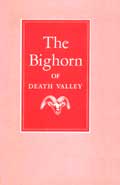.gif)
MENU
![]() Life History
Life History
|
Fauna of the National Parks — No. 6
The Bighorn of Death Valley |

|
LIFE HISTORY OF THE DEATH VALLEY BIGHORN
Diseases and Parasites
We have been able to accumulate practically no data on the incidence and type of sickness among Death Valley bighorn.
The cause of the symptoms of the Nevares sheep described above was never determined and apparently was overcome by the adult members of the band. It might, however, have contributed to the absence of yearlings in 1957.
We were unable to determine whether the poor condition of The Old Lady at Nevares was solely because of old age or aggravated by pathological complications.
Old Mama of Furnace Creek Wash had a sporadic cough and nasal discharge which seemed to affect her energy in no way. Her lamb, on the other hand, developed a severe cough accompanied by badly swollen eyes and considerable lethargy. The lamb was better when last seen, but on the following November when Old Mama returned to the wash she was alone.
The symptoms described above are common among Death Valley lambs but the cause or causes of the symptoms and their ultimate development are not known.
Lungworm (Protostrongylus stilesi) was established as existent in the Death Valley area by laboratory tests conducted by the California Department of Fish and Game on fecal deposits collected during the 1955 census.
We found no incidence of either warbles or ticks.
Adult skulls collected during this survey have been remarkably free from dental abnormalities, indicating a low incidence of Actinomyces bovis. One ram skull has upper canines.
Continued >>>
 Top
Top
Last Modified: Thurs, May 16 2002 10:00:00 pm PDT
http://www.cr.nps.gov/history/online_books/fauna6/fauna2l.htm
![]()
